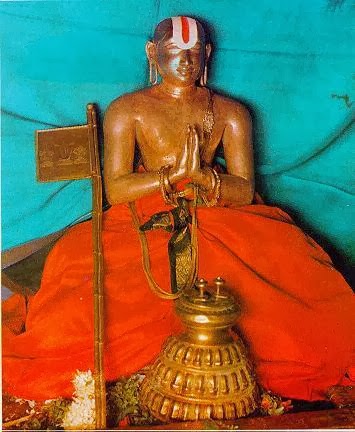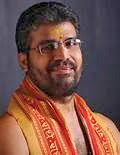Sri Ramanujacharya Life History : 6.
EVENTS IN THE LIFE OF SRI RAMANUJA (Continues....)
(11) After Mastering the Bodhaayana Vritti of Sage Vyaasa, he wrote several works like Vedanta Sangraham explaining the various viewpoints of Sankara, Yadhava, Bhaskara and others, Vedanta Deepam, Geetha Bashyam etc.
(12) During Panguni Uttram, he did Prapatti before the Divya Dhampathi in Serthi and submitted his famous Gadhyatrayam (comprising Saranagathi Gadhyam, Sriranga Gadhyam and Sri Vaikunta Gadhyam ),
(13) Later, he wrote a Grantha called Nityam detailing the Tiruvaradhana Kramam
(14) While he was on his Sancharam, it is believed that the Lord himself appeared before him at Tiruk Kurum Kudi as a Srivaishnava got Samasrayanam from Udaiyavar (PPM)
(15) When he visited Saraswati Peetam, Goddess Saraswati was so impressed with his commentary on Brahma Sutram that she named it "Sri Bhashyam" and conferred on him the title of "Bhashyakaarar". It must be noted that while the other commentaries are known by the names of their authors like 'Sankara Bashyam' written by Aadhi Sankara, the commentary of Ramanuja is always referred to with the venerable honorific 'Sri' denoting its unsurpassed quality and clarity and known as ' Sri Bashyam' (PPM)
(16) When he visited Tirumala, a miracle happened. Some argued that the Lord of Tirumalai was Saiva param. It is surprising that such a claim should have arisen about the Lord who had been worshipped as Lord Vishnu by all the Alwars and Acharyas besides Elango Adigal and other Tamil Pulavars for several centuries. This was because the Lord had earlier entrusted His insignia to a King called Tondamaan. (SAA p.57-58). The Lord desired to take back from Tondamaan, these insignia viz., Sankhu, Tiruvaazhi, Soolam, Damarukam etc. They were placed in the Sannidhi the previous night. And, when the doors were opened the next morning, the Lord gave Darshan adorning all his insignia (PPM). Ramanuja was hailed as " Appanukku Sangaazhi Alittha Perumaal" Poet Arunagiri himself sang clearing all doubts in this regard saying "Ulageenra Pachai umaiyanan, Vada Venkadathil Uraibhavan, Uyar Sanga Chakra kara Thalan"
(17) Ramanuja "was the greatest synoptic thinker which the world ever produced to systematize Visishtadvaitic philosophy, faithfully interpreting the ancient knowledge in tune with the letter and spirit of the text in the light of revelation and experience tested by stern logic"- [- Hon'ble Justice K.S.Krishnaswami Iyengar of the High Court of Judicture, Madras in his foreword to Desika Prabahandam( P.31) published by Lifco Associates, Madras- 3rd Edition, 1982. ]
(18) His magnum opus is his wonderful commentary on Vedavyasa's Brahma Sutram and a simpler commentary thereon called Vedanta Saram. Kuresan was very helpful in publishing his works. Thus, he fulfilled his FIRST PROMISE to Alavandar. It is this Kuresan (aka) Sri Vatsanka Misra who wrote the famous Pancha Sthava consisting of Athi Maanusha Sthava, Sri Sthava, Varadaraja Sthava, Vaikunta Sthava and Sundarabaahu Sthava.
(19) He asked Kuresan to name his two sons after Veda Vyasa and Parasara and thus fulfilled his SECOND PROMISE to Alavandar. It was this Parasara Bhattar who subsequently wrote the famous commentary on Vishnu Sahasra Nama as ordained by Ramanuja.
(20) Another disciple of Ramanuja was Pillaan. Once, when Ramanuja was alone mentally reciting a particular hymn of Tiruvoimozhi, Pillaan entered his room and inquired if he was meditating on a particular hymn. And, it was indeed the one Ramanuja was actually meditating on!. Ramanuja decided that Pillaan was the person best suited to write a commentary on Tiruvoimozhi. As ordered, he wrote the famous 'AARAAYIRAPPADI' (the commentary known as the 6000 Padi also known as Bhagavad Vishayam) and called Pillaan as 'Tirukkurugai Piraan' after the name of Nammalwar. He was also known as Kurugesar and Braathru Thozhappar. Thus, he fulfilled his THIRD PROMISE to Alavandar. He was one of the Sri Bhashya ubhaya Simhasana Adhipathis.(PPM)
(21) Kulothunga Chola was a staunch devotee of Siva. He commanded Ramanuja to come to his court with a view to enlisting his support to establish the superiority of Siva over all other deities. (including Vishnu ). If the support was not forthcoming, the king was planning to kill Ramanuja. Sensing the danger, Kuresa went to the court disguised as Ramanuja along with another disciple called Periya Nambi. The king ordered him to sign a document to the effect that 'Siva is the greatest'. Kuresa added that ' Sivam was no doubt great but Dronam was greater than Sivam'- both expressions referring to units of measurement. The enraged king ordered both of them to be blinded when he came to know that he was Kuresa who was impersonating Ramanuja. Periya Nambi was tortured to death while Kuresa survived. Kuresa, though he himself was blinded, was happy that he had saved Ramanuja. It is this Kulothunga who is reported to have thrown away the idol of Govindaraja in the sea. Ramanuja recovered it and had it installed at Tirupati.
(22) While on an itinerary, Ramanuja noticed an officer of state, by name Danur daasa, a hunter by birth was over -concerned and over- protective about the beauty of his wife who was walking along on the hot sands on the banks of the river Kaveri. Ramanuja offered to show him something more beautiful than his wife and took him to the proximity of the image of Lord Ranganatha. Danur daasa was enraptured by the charm of the Lord and became a disciple of Ramanuja assuming the name of ' Uranga Villi Daasar'. Ramanuja never entertained any caste distinctions and was conferring his benedictions even on the lowliest of the lowly whom he called 'Tiruk Kulattar'.
(23) Ramanuja went to Tiru narayana puram in search of white clay paste used for applying caste marks by Vaishnavites. The idol of the temple there had been taken away by the muslim invaders and was being used at play as a doll by the muslim princess in Delhi. Ramanuja went to Delhi and when he endearingly called ' Come on! My dear child 'Selva Pillaiye Vaarum', the idol miraculously came onto his lap. Ramanuja reinstalled it in the temple.
(24) Once some kids were playing on the road pretending to construct a temple, installing an idol of the Lord, offering fruits and flowers etc all the time using the dust on the road for the purpose. They offered some mud as prasadam to Ramanuja who was passing along , he received it with due respect. He remembered in this connection the words of Poigai Alwar who said that the Lord took whatever name and form his sincere devotees wished and in the instant case though the kids were only playing, they sincerely believed in what they were doing.
(25) Another disciple of Ramanuja was Vaduga Nambi who put the sandals of his Guru along with those of the Lord. When questioned, he replied that the Acharya's sandals were for him as holy as those of the Lord. When Lord Ranganatha was coming on his rounds on the streets of Srirangam, Vaduga Nambi remarked that the eyes that had seen the charm in the eyes of Ramanuja would not be able to appreciate the beauty of the eyes of even the Lord.-'En Amudinai Kanda Kangal Marronrinai Kaanaave.' Such was his devotion to his Acharya.
(26) Ramanuja arranged to make a lifelike idol of himself and embracing it invested it with his powers and had it installed in Tirumalai at Tirupati. The only temple consecrated in Tirumalai , other than that of Lord Venkateswara, is that of Ramanuja.(SAA p.58) The Archa moorthi of Ramanuja known as "Thaan Ugantha Tirumeni" was installed in Tirunarayanapuram.
(27) Once, when he visited Tondanoor in Hoysala State, he happened to meet a Jain king called Devarayan. His daughter was possessed by a demon and none could get rid of her predicament. When Ramanuja's SriPaada Theertham ( water consecrated by association with his feet) was sprinkled on her,she was cured of the devil. The King pleaded to be accepted as Ramanujas Sishya. Ramanuja accepted and named him "Vishnu Vardhana".
(28) Ramanuja nominated 74 Acharyas to succeed him. It is he who instituted the 13 day "iyal oshti in Srirangam." (PPM)
NEXT : HIS ASCENT TO PARAMAPADAM.
Continues...




Comments